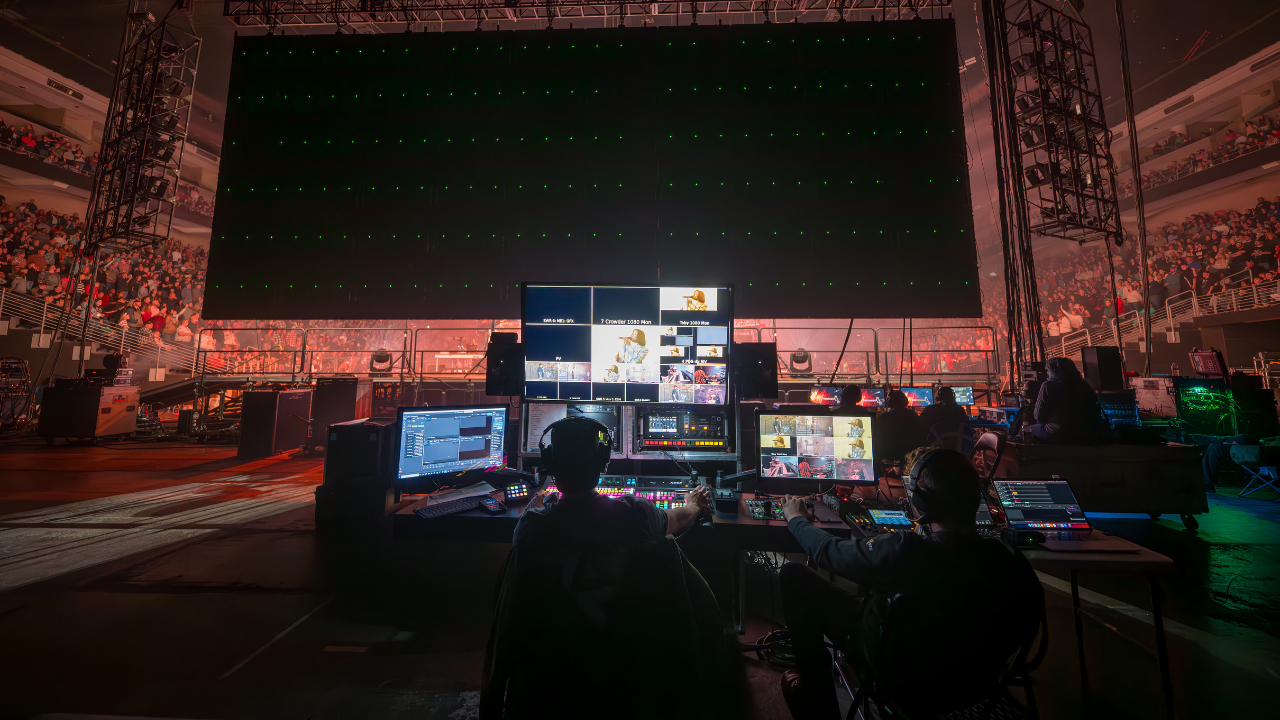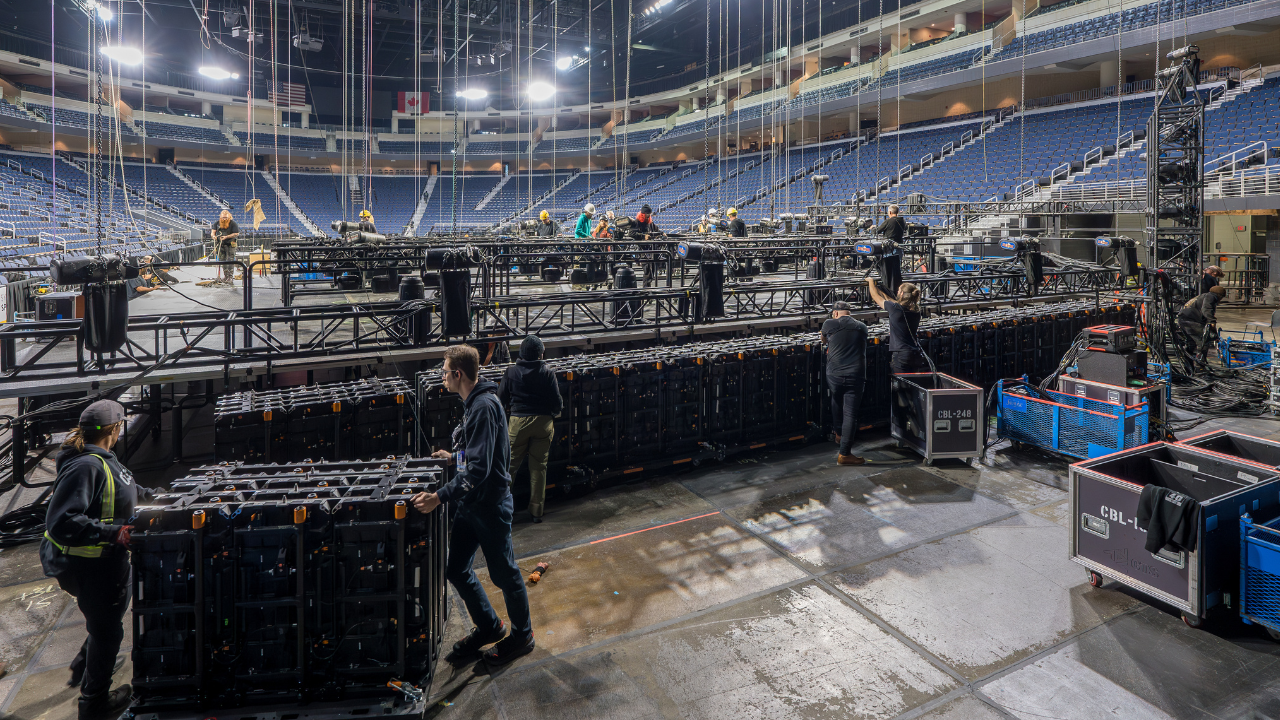Church Stage Lighting on a Budget
Published on: Tuesday, February 22, 2022 - 7:00am

Are you still living with lighting dimmers and conventional fixtures? Did your church stage lighting budget take the biggest hit during your latest technology renovation, or are you simply struggling to get what you need out of your current system? You’re not alone.
In fact, in our experience, we’ve found two things to be true when it comes to budget for church construction and renovation.
- Pretty much everyone’s initial designs and ideas outstrip their budgets.
- Church stage lighting is consistently the first thing to get cut.
It’s great to dream big. But when you start to reconcile your church’s big dreams with its budget, you’re forced to make some value decisions to ensure that everything fits financially. This often means that lighting gets cut down more significantly than any other system.
How can you get your church’s message out of the dark and into the spotlight without breaking the bank or putting yourself in a tight spot?
In this post, we’ll talk about why lighting gets cut first and what steps you can take to work around that limitation without sacrificing creativity.
Why Does Church Stage Lighting Get Left in the Dark?
Why Not Audio?
Audio never seems to suffer the setbacks of lighting. Why is that?
Audio doesn’t get cut because the message is the whole point. Whether it’s a sermon or a song, it doesn’t matter how good the video and lighting are if people can’t hear and understand.
A bad sound system or unintelligible PA completely disrupts a message, regardless of how well-lit the pastor is. The spoken word is important, and to make its mark, people have to be able to hear it clearly.
If the congregation has to strain to hear the message, it won’t matter how stunning and impressive the lights are, or how enveloping and creative the environment. They’ll leave the room exhausted and drained instead of inspired and invigorated.
Maintaining a solid audio system makes much more sense than cutting it in favor of a larger lighting rig. This may lead to lighting frustrations down the road, but at the very least, everyone can hear the words clearly.
Why Not Video?
Video has become a huge part of our culture. Churches produce video of all kinds to support the message and engage the worshippers. They aren’t quick to reduce the budget for the video system because that will in turn reduce the media team’s flexibility to create compelling visual content.
If your video system is limited, your team will also be limited in what kind of content they can capture and create. It makes sense then that churches would value video over stage lighting when considering the future needs of their congregation.
Why Lighting?
Lighting isn’t usually cut completely. No one wants to sit in the dark. But it’s third in line on the priorities list, and therefore takes the biggest budget hits.
You can get away with some very basic lighting for a little while: maybe a front and back wash with a little bit of color. Most people won’t notice a thing if they don’t have a history with really high-level, modern, creative lighting.
If you have a tight budget, then replacing old basic lighting with new basic lighting might be the route you have to take. Many churches would rather remove limitations on creativity by investing in a large LED wall or a better sound system for their space than extra lighting fixtures.
Additionally, churches can’t always find or hire staff like high-level lighting designers and operators who know how to effectively use a large lighting system. In many cases, an audio tech also programs the lighting, or a video team also works with the lighting system in their spare time.
More sophisticated church stage lighting systems, then, are relatively foreign, and fewer people have the skills and knowledge to push for them.
How Does Lighting Impact the Worship Experience?
Lighting is another form of communication with your congregation.
Audio communicates the words and tones of a message or song. Video communicates visual information that tells a story, relates a testimony, or enhances the meaning of the message or song. And lighting communicates, too.
Lighting tells the congregation where to look, where not to look, and when to participate. It evokes emotion, aids in storytelling, and works together with music to direct the worshippers’ focus. Lighting helps to create the most engaging and immersive worship experience possible.
Poor lighting can do the opposite. If odd shadows obscure the pastor, or a screen glare interferes with viewing the media team’s video, worshippers become distracted and pulled out of the experience.
Today, too, as many churches have moved into a hybrid model that includes live broadcast and online streaming, lighting affects online churchgoers’ experience. Improper or inadequate lighting gives video a two-dimensional, low-quality feel, regardless of the quality of the cameras. In fact, you can shortchange an excellent video system by using a subpar church stage lighting system.
So while audio and video are important, lighting affects the quality of the environment and the flexibility to change that environment. It also greatly impacts the ability to capture clear and effective video to bring remote worshippers into the most immersive experience possible.
Should You Rent or Buy?
If your church stage lighting isn’t where you want it to be, how can you overcome the system’s limitations within your budget?
The two main options are to rent additional equipment on an as-needed basis or to buy new equipment as a permanent resource.
Renting and buying are two very different paths. Both can work, depending on your needs. Both are legitimate, functional solutions that churches use every day. The key is not to fall into a choice by accident. Instead, you have to know what decision you’re making and choose it intentionally.
Rent What You Need
Because churches often reduce lighting systems during the initial design, they probably spend more money per year on lighting rentals than on any other system. So whether it be for an Easter service or a special sermon series, a church has to rent to give their team the flexibility to meet all the ministry’s specific needs.
Below are some principles that will help you make the best decisions about lighting rentals.
Track Your Needs
Some churches prefer to rent because they need such dramatically different types of fixtures from event to event. They don’t want to buy and commit themselves to just one type of fixture. So to increase their flexibility and avoid tying their creativity to one or two types of fixtures, they choose to rent.
The opposite of this is when a church rents stage lighting repeatedly without considering future needs or past patterns. If the team consistently decides to rent during the hectic, last-minute scramble before an event, chances are no one is keeping track — of this rental, past rentals, or probable future rentals. By becoming intentional, you might look at your records and realize the church rents the same five types of fixtures every year, and could have bought them three times over already!
When you’re intentional about choosing whether to rent or buy, you’ll make decisions based on patterns, experience, and projections instead of last-minute reactions.
Plan Your Budget
Churches that intentionally choose to rent their stage lighting also intentionally build rentals into their operating budget. They recognize that they don’t own the lights they need. They acknowledge that they spend $20,000 or $40,000 a year on lighting rentals for special events. And they plan for it by carrying an appropriate level of rental budget in their operating budget for the year to come.
If the rental costs for a certain fixture begin to approach or surpass the cost of buying it, then you know it’s time to have a discussion about planning for purchasing.
Consider the Tradeoffs
Renting can provide the flexibility to use a wide variety of stage lighting fixtures without being tied down to a limited few in your possession. However, it can also limit the day-to-day resources to carry out what a ministry wants to do if the fixtures aren’t always on hand.
Additionally, by renting you don’t have to commit the upfront capital resources to purchasing and installation that you would if buying. However, you do have to carry higher operating capital to spend on something you won’t own.
Buy What You Need
By virtue of the realities we’re discussing here, lighting ends up being upgraded and renovated far less often than audio and video, so once your church stage lighting system is installed, you’re committed to that investment for the next decade or so. If budget limitations meant cuts to that lighting system, you might not have everything you need for the future.
Remember these principles to be intentional about budgeting for your church stage lighting needs.
Look at How Often You Need It
If your needs change constantly or if you never need the same fixture twice, renting is probably the better solution for you. But if you run the same event or effect three to five times a year, you would probably be better off buying.
Consider times you’ve had to work around equipment you couldn’t get. What missing pieces have limited the creativity and flexibility of your church’s team? Is there a consistent need for a certain missing stage lighting fixture?
Now consider the purpose of any fixture you’re thinking of buying. If it would only be useful once a year, maybe you should rent. If you’d use it multiple times, consider buying.
Consider the DNA of Your Congregation
Every church is different. Some prefer a high level of production value, with moving lights and more specific effects. Others prefer a very simple environment without a lot of color; they just want it to feel and look comfortable.
Neither way is wrong. But in deciding what to purchase, you have to know the DNA of your church. If a proper front wash and backwashing key light make everyone happy and fulfill the need, then you can stop there. If the church wants a higher production value, you can consider which tools will provide the most flexibility and value on an ongoing basis.
The key here is not to overspend on extra fixtures that don’t match your ministry.
Would It Add to the Creativity and Effectiveness of the Ministry?
One reason lighting gets cut from budgets is because people ask this question: Can I live without it?
The answer to that question is very often, Yes, yes you can.
As long as you have a proper front wash and key lighting with a little bit of texture, you can live without the effect and color lighting fixtures. But that doesn’t mean you wouldn’t use them if you had them.
New lighting fixtures bring new mood and texture opportunities for the stage and environment, and new opportunities for creativity for the staff and the ministry. If you choose intentionally, you’ll use your new lighting resources more than you think. If they’re the right fixtures in the right places, you’ll find ways to use them.
Choose the Best Solution for Your Situation
Even if your church had to make sacrifices to its stage lighting system, renting or buying new fixtures to supplement your system allows you to add creativity and flexibility. Both are good options for the right situation. By keeping the principles above in mind, you can choose the best solution for your church’s up-to-date needs.



